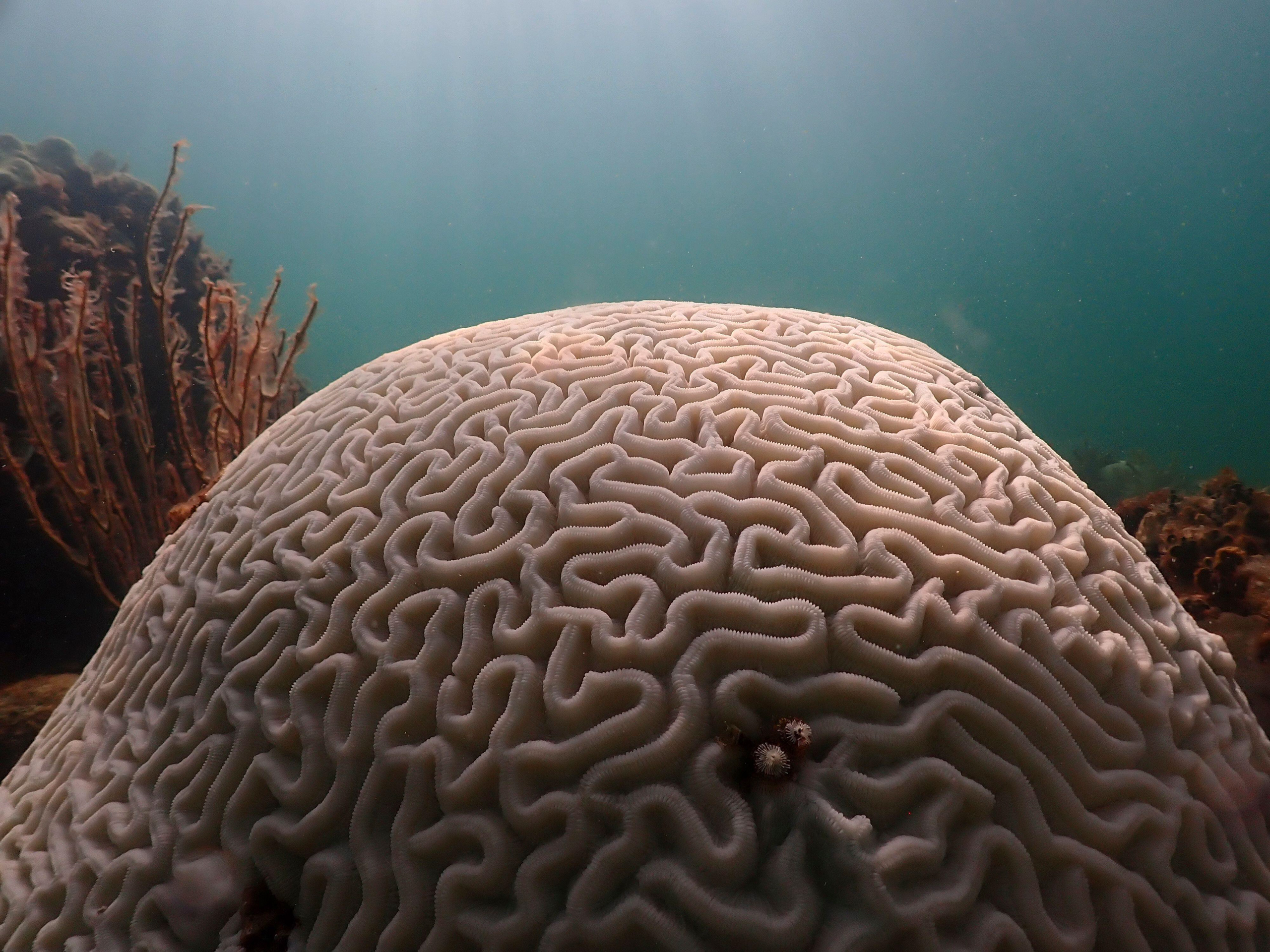When the water off the coast of Florida reached nearly 38C last year, corals simply could not cope. Reefs bleached en masse, turning deathly white after corals ejected the symbiotic algae that provide them with food via photosynthesis.
The Coral Restoration Foundation (CRF), based in the Florida Keys, cultivates coral in 6,000 square metres of ocean-based nurseries. It lost half of the corals it was rearing in nurseries for transplantation onto the region’s degraded reefs, and suffered the near-total death of the threatened acroporid corals it had been painstakingly restoring.
It was a major blow to efforts to restore damaged reefs, and symptomatic of how the current playbook for helping corals in uncomfortably hot water is struggling to cope with surging temperatures.
Corals in hot water
The state of coral reefs globally has led to increasingly alarming warnings from scientists, as ocean temperatures have broken records month after month in 2023 and 2024. After summer 2023, the US National Oceanic and Atmospheric Administration (NOAA) extended its alert scale for coral heat warnings. It added three new higher-risk categories, the highest being “near complete mortality”.
In April this year, NOAA and an international network of reef scientists confirmed Earth is currently experiencing its fourth global coral bleaching. This is the second in ten years. Corals can bounce back after bleaching, but long-term survival depends on having sufficient time to recover. Corals on Australia’s 3,200-kilometre Great Barrier Reef are currently experiencing a fifth mass bleaching in eight years.
“Each time we break and blast through records, it’s a sobering wake-up call, even for the scientific community,” says Lizzie McLeod, global ocean director at The Nature Conservancy, a US-based conservation organisation. “In some cases last year, the corals didn’t even bleach, they just died immediately.”
Coral reefs cover less than 1% of the world’s surface area, yet support 25% of all marine species. Vital for coastal communities, an estimated one billion people rely on them for food and livelihoods. A vast number of homes and businesses are protected from damage during storms by reefs that dissipate the power of waves.
As concern has grown, attempts to protect reefs from heat have spread. Protective screens have been erected as underwater parasols over some reefs. Divers have been banned from popular areas to reduce potential damage. In some cases, corals have been physically moved to deeper, cooler waters or taken out of the ocean entirely for safekeeping in aquariums.
There has also been a surge of interest in reef restoration projects, which have proliferated around the world. Many focus on identifying those species and locations where corals are proving more resilient to heat stress. Their genetics are then reproduced using cultivated coral to restore damaged reefs and make them more resilient to climate change. Such coral gardening – collecting, transplanting and re-attaching coral colonies or branch fragments to repair a degraded site – is expensive and labour-intensive, because it requires very large numbers of corals per hectare.
Some scientists are sceptical that such projects are viable for the long-term survival of reefs. In 2021, a consortium of G20 countries and the International Coral Reef Initiative said new restoration tools were needed, because most methods were suitable only for small-scale intervention.
In March, professor Terry Hughes of Australia’s James Cook University wrote: “Attempts to restore depleted coral cover through coral gardening, assisted migration (by harvesting larvae) and assisted evolution (rearing corals in an aquarium) are prohibitively expensive and unworkable at any meaningful scale.”
Hughes was citing a recent feasibility study conducted by the Australian government that eliminated the option of assisted migration, due to its risks. Another study, co-authored by Hughes, found the Great Barrier Reef would need an additional 10,000 hectares of coral tissue to increase its coral cover by just 1%, rendering the approach unworkable.
Seeing opportunity in Florida’s tragedy
The Florida team remains upbeat after their 2023 setback. They planned for a hot summer, and evacuated representative samples of corals to onshore facilities to try and safeguard the reef’s genetic diversity.
Lessons learned from other extreme weather events also helped. When hurricane Irma hit the Florida Keys in 2017, it wiped out around 50% of all the corals the team had restored since it started work in 2007. That was a “huge blow”, says Alice Grainger, CRF’s senior director of strategic engagement. Yet in the two years following the storm, she says her teams restored more coral than in the 10 years leading up to it.
The reefs off Florida are among the most degraded in the world due to pollution, climate change and other pressures. They were at just 2% of their historical range before the most recent bleaching. But Grainger remains positive her programme can help turn things around.
“We’re very confident that in the next two to three years we’ll be able to get as many corals back onto the [restored] reefs as we lost last year,” she says. The experience will help the group improve the resilience of its nurseries and its future programmes, she adds.
Last year’s heat also shed new light on the genetic diversity of coral. Grainger says the same species of coral reacted differently depending on location, demonstrating that coral resilience hinges on multiple factors including bacteria and viruses around the coral, the water quality and its turbidity.
“Corals that were very resilient in one location were not the same in another. That’s really critical – there is resilience in genetic diversity,” she says.
Collaboration for corals
Others see hope in improved collaboration to accelerate the sharing of discoveries on how corals respond to heat. For example, the insights into coral genetics that were made possible by Grainger’s team of scientists, marine managers and communities.
With this acceleration in mind, the Marine Ecological Research Management AID (Mermaid) open-source platform was created in 2020 by the Wildlife Conservation Society (WCS), an NGO headquartered in New York.
Researchers collect reef data underwater with pencils and clipboards. This has traditionally been followed by hours of manual data entry and checking using spreadsheets. According to Emily Darling, director of coral reef conservation at the WCS, such laborious data-logging processes have significantly delayed decisions on how to manage reefs.
But using Mermaid, more than 2,000 scientists in 35 countries can now put their clipboard observations on reef health directly into the platform. This makes them available to colleagues much more quickly.
Darling describes a success story in Fiji, where community elders decided to close their local marine reserve to fishing after scientists using Mermaid were able to share data directly with them. The data showed that though the reef was recovering from a cyclone in 2016, fish populations were still below sustainable thresholds.
“Tools like Mermaid can really bring together this data at the scales and on the timelines that are needed,” she says. “It’s just unacceptable that we don’t have a global picture of the status and trends of coral reefs that’s not already years out of date.”
The Nature Conservancy is also stepping up collaboration. Its “super reefs” project aims to identify areas of coral that do less badly in warmer water and therefore have potential to reseed neighbouring reefs. It wants the findings to be quickly translated into lessons for restoration practitioners and applied in the field.
“There’s often a miscommunication between scientists and conservationists. A lot of great research is never applied,” says Annick Cros, TNC’s reef project manager. “Meanwhile, there are requests from reef managers that are not heard by researchers.”
Run in collaboration with the Woods Hole Oceanographic Institution and Stanford University in the US, the project is currently searching for super reefs in the Marshall Islands, Hawaii and Belize.
Buying time
Scientists working for the UN’s climate science body, the Intergovernmental Panel on Climate Change, predict that reefs will decline by a further 70-90% at 1.5C of global warming above pre-industrial temperatures, with losses of more than 99% at 2C. Understanding and restoring reefs is therefore just one part of the equation needed to save coral in the long-term; drastic reductions in greenhouse gases and local pollution are also vital.
“Our role is not necessarily to maintain reefs the way we know them today,” Cros says. “It is to keep the ecosystem functioning for as long as we can to give communities time to either change livelihood, or adapt, and for us to come up with better solutions for climate change and all the other things that are impacting reefs.”
In Florida, Grainger says banking the genetic material of the corals is effectively “putting our finger in the dam”.
“We’re working to restore these ecosystems for the communities that depend on them – we can’t abandon them, even if our work is wiped out every 10 years,” she says.
“We’re keeping these [coral] populations from going extinct, and we have the capacity to bring them back on a massive scale. But if we don’t work towards a carbon-negative future, then coral reefs really don’t stand a chance.”
This article was updated on 14 October 2024 to correct an earlier error: the super reefs project is currently working in the Marshall Islands, Hawaii and Belize but not in the Bahamas.










